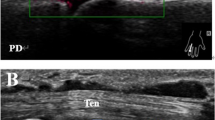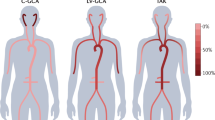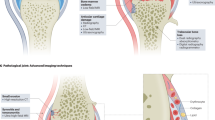Abstract
An increasing number of rheumatologists have access to ultrasound equipment that provide both color and power Doppler modes, which can be used to investigate musculoskeletal and vascular pathologies. Musculoskeletal Doppler ultrasonography can be used to estimate levels of inflammation, to document the anti-inflammatory effect of agents such as corticosteroids and tumor necrosis factor inhibitors, to differentiate between inflammatory and degenerative disease, and to distinguish between normal and inflamed joints in cases of minor synovial swelling. Vascular Doppler ultrasonography can be used to determine organ involvement in small-vessel vasculitides, to delineate aneurysms in vasculitides of medium-sized arteries, and to assess the characteristic findings in large-vessel vasculitis. Numerous studies, including a meta-analysis, have been published on the use of temporal-artery ultrasonography for the diagnosis of giant cell arteritis. Duplex ultrasonography is a sensitive approach for detecting characteristic edematous wall swellings in active temporal arteritis and for assessing vasculitis of the axillary arteries (large-vessel giant cell arteritis) in patients with suspected temporal arteritis, polymyalgia rheumatica, or fever of unknown origin. Duplex ultrasonography can also be used to assess vasculitis of subclavian and carotid arteries in younger patients with Takayasu's arteritis and acute finger artery occlusions in patients with small-vessel vasculitides.
Key Points
-
Doppler ultrasonography provides clinically important information in rheumatology
-
Doppler ultrasonography of joints and tendons allows for assessment of inflammation, documentation of the effect of anti-inflammatory agents, and differentiation of inflammatory disease from degenerative disease
-
Semiquantitative evaluation of color signals is most commonly used: Grade 0, no color signal; grade 1, single vessel signals; grade 2, confluent vessel signals; grade 3, more than 50% of the area of the synovium is covered with color signals
-
In small-vessel vasculitides, ultrasonography assesses pathologies that are secondary to vasculitis; in medium-sized-artery vasculitides, aneurysms can be detected; in large-vessel vasculitides, ultrasonography delineates characteristic, homogeneous, circumferential wall swellings
-
In temporal arteritis, further characteristic signs of inflammation are stenosis and acute occlusion
-
In patients with temporal arteritis, polymyalgia rheumatica, or fever of unknown origin, it is recommended that the axillary arteries are investigated with Doppler ultrasonography, as large-vessel giant cell arteritis is more common than previously thought
This is a preview of subscription content, access via your institution
Access options
Subscribe to this journal
Receive 12 print issues and online access
$209.00 per year
only $17.42 per issue
Buy this article
- Purchase on Springer Link
- Instant access to full article PDF
Prices may be subject to local taxes which are calculated during checkout



Similar content being viewed by others
References
Schmidt WA (2004) Doppler sonography in rheumatology. Best Pract Res Clin Rheumatol 18: 827–846
Newman JS et al. (1994) Detection of soft-tissue hyperemia: Value of power Doppler sonography. AJR Am J Roentgenol 153: 385–389
Terslev L et al. (2005) Doppler ultrasound findings in healthy wrists and finger joints before and after use of two different contrast agents. Ann Rheum Dis 64: 824–827
Schmidt WA et al. (2000) Colour Doppler ultrasonography to detect pannus in knee-joint synovitis. Clin Exp Rheumatol 18: 439–444
Wakefield RJ et al. (2005) Musculoskeletal ultrasound including definitions for ultrasonographic pathology. J Rheumatol 32: 2485–2487
Szkudlarek M et al. (2001) Power Doppler ultrasonography for assessment of synovitis in the metacarpophalangeal joints of patients with rheumatoid arthritis: a comparison with dynamic magnetic resonance imaging. Arthritis Rheum 44: 2018–2023
Weidekamm C et al. (2003) Diagnostic value of high-resolution B-mode and doppler sonography for imaging of hand and finger joints in rheumatoid arthritis. Arthritis Rheum 48: 325–333
Naredo E et al. (2005) Ultrasonographic assessment of inflammatory activity in rheumatoid arthritis: comparison of extended versus reduced joint evaluation. Clin Exp Rheumatol 23: 881–884
D'Agostino MA et al. (2003) Assessment of peripheral enthesitis in the spondylarthropathies by ultrasonography combined with power Doppler: a cross-sectional study. Arthritis Rheum 48: 523–533
Kiris A et al. (2006) Assessment of enthesitis in ankylosing spondylitis by power Doppler ultrasonography. Skeletal Radiol 35: 522–528
Salaffi F et al. (2004) Contrast-enhanced power Doppler sonography of knee synovitis in rheumatoid arthritis: assessment of therapeutic response. Clin Rheumatol 23: 285–290
Hau M et al. (2002) High resolution ultrasound detects a decrease in pannus vascularisation of small finger joints in patients with rheumatoid arthritis receiving treatment with soluble tumour necrosis factor alpha receptor (etanercept). Ann Rheum Dis 61: 55–58
Terslev L et al. (2003) Effects of treatment with etanercept (Enbrel, TNRF:Fc) on rheumatoid arthritis evaluated by Doppler ultrasonography. Ann Rheum Dis 62: 178–181
Fiocco U et al. (2005) Rheumatoid and psoriatic knee synovitis: clinical, grey scale, and power Doppler ultrasound assessment of the response to etanercept. Ann Rheum Dis 64: 899–905
Taylor PC et al. (2006) Ultrasonographic and radiographic results from a two-year controlled trial of immediate or one-year-delayed addition of infliximab to ongoing methotrexate therapy in patients with erosive early rheumatoid arthritis. Arthritis Rheum 54: 47–53
Strunk J et al. (2003) Doppler sonographic findings in the long bicipital tendon sheath in patients with rheumatoid arthritis as compared with patients with degenerative diseases of the shoulder. Arthritis Rheum 48: 1828–1832
Schmidt WA et al. (2004) Standard reference values for musculoskeletal ultrasonography. Ann Rheum Dis 63: 988–994
Joshua F et al. (2005) Power Doppler 'blanching' after the application of transducer pressure. Australas Radiol 49: 218–221
Cook JL et al. (2005) Is vascularity more evident after exercise? Implications for tendon imaging. AJR Am J Roentgenol 185: 1138–1140
Scheel AK et al. (2005) Interobserver reliability of rheumatologists performing musculoskeletal ultrasonography: results from a EULAR “Train the trainers” course. Ann Rheum Dis 64: 1043–1049
Naredo E et al. (2006) Inter-observer reliability in musculoskeletal ultrasonography: results from a “Teach-the-Teachers” rheumatologist course. Ann Rheum Dis 65: 14–19
Oliveira GH et al. (2005) Echocardiographic findings in patients with Wegener granulomatosis. Mayo Clin Proc 80: 1435–1440
Newburger JW et al. (2004) Diagnosis, treatment, and long-term management of Kawasaki disease: a statement for health professionals from the Committee on Rheumatic Fever, Endocarditis, and Kawasaki Disease, Council on Cardiovascular Disease in the Young, American Heart Association. Pediatrics 114: 1708–1733
Schmidt WA et al. (1997) Color duplex ultrasonography in the diagnosis of temporal arteritis. N Engl J Med 337: 1336–1342
Vianna RN et al. (2005) The role of ultrasound biomicroscopy in predicting the result of temporal artery biopsy in temporal arteritis patients: a preliminary study. Eur J Ophthalmol 15: 655–659
Bruyn GA and Schmidt WA (2006) Introductory Guide to Musculoskeletal Ultrasound for the Rheumatologist. The Netherlands: Bohn Stafleu van Logum
Karassa FB et al. (2005) Diagnostic performance of ultrasonography for giant-cell arteritis: a meta-analysis. Ann Intern Med 142: 359–369
Schmidt WA and Gromnica-Ihle E (2003) Duplex ultrasonography in temporal arteritis. Ann Intern Med 138: 609
Schmidt WA and Gromnica-Ihle E (2005) What is the best approach to diagnose large-vessel vasculitis? Best Pract Res Clin Rheumatol 19: 223–242
Müller E et al. (2004) Temporal arteritis with pauci-immune glomerulonephritis: a systemic disease. Clin Nephrol 62: 384–386
Bley TA et al. (2005) High-resolution MRI in giant cell arteritis: imaging of the wall of the superficial temporal artery. AJR Am J Roentgenol 184: 283–287
Schmidt WA and Gromnica-Ihle E (2002) Incidence of temporal arteritis in patients with polymyalgia rheumatica—a prospective study using colour Doppler ultrasonography of the temporal arteries. Rheumatology (Oxford) 41: 46–52
Cantini F et al. (2001) Shoulder ultrasonography in the diagnosis of polymyalgia rheumatica: A case-control study. J Rheumatol 28: 1049–1055
Cantini F et al. (2005) Inflammatory changes of hip synovial structures in polymyalgia rheumatica. Clin Exp Rheumatol 23: 462–468
Schmidt WA et al. (2002) Involvement of peripheral arteries in giant cell arteritis: a color Doppler sonography study. Clin Exp Rheumatol 20: 309–318
Schmidt WA and Blockmans D (2005) Use of ultrasonography and positron emission tomography in the diagnosis and assessment of large-vessel vasculitis. Curr Opin Rheumatol 17: 9–15
Brodmann M et al. (2004) The role of 2-18F-fluoro-2-deoxy-D-glucose positron emission tomography in the diagnosis of giant cell arteritis of the temporal arteries. Rheumatology (Oxford) 43: 241–242
Pfadenhauer K et al. (2005) Vertebrobasilar ischemia and structural abnormalities of the vertebral arteries in active temporal arteritis and polymyalgia rheumatica—an ultrasonographic case-control study. J Rheumatol 32: 2356–2360
Kerr G et al. (1994) Takayasu arteritis. Ann Intern Med 120: 919–929
Schmidt WA et al. (2002) Diagnosis of early Takayasu arteritis by colour Doppler ultrasonography. Rheumatology (Oxford) 41: 496–502
Ringleb PA et al. (2005) Cerebrovascular manifestations of Takayasu arteritis in Europe. Rheumatology (Oxford) 44: 1012–1015
Schmidt WA et al. (2006) Colour duplex sonography of finger arteries in vasculitis and in systemic sclerosis. Ann Rheum Dis 65: 265–267
Cook JL et al. (2005) High reproducibility of patellar tendon vascularity assessed by colour Doppler ultrasonography: a reliable measurement tool for quantifying tendon pathology. Br J Sports Med 39: 700–703
Carotti M et al. (2002) Power Doppler sonography in the assessment of synovial tissue of the knee joint in rheumatoid arthritis: a preliminary experience. Ann Rheum Dis 61: 877–882
Klauser A et al. (2005) Contrast enhanced gray-scale sonography in assessment of joint vascularity in rheumatoid arthritis: results from the IACUS study group. Eur Radiol 15: 2404–2410
Author information
Authors and Affiliations
Ethics declarations
Competing interests
The author declares no competing financial interests.
Rights and permissions
About this article
Cite this article
Schmidt, W. Technology Insight: the role of color and power Doppler ultrasonography in rheumatology. Nat Rev Rheumatol 3, 35–42 (2007). https://doi.org/10.1038/ncprheum0377
Received:
Accepted:
Issue Date:
DOI: https://doi.org/10.1038/ncprheum0377
This article is cited by
-
Takayasu Arteritis: Recent Developments
Current Rheumatology Reports (2019)
-
Settings and artefacts relevant for Doppler ultrasound in large vessel vasculitis
Arthritis Research & Therapy (2017)
-
A Functional Study of Human Inflammatory Arthritis Using Photoacoustic Imaging
Scientific Reports (2017)
-
Ultrasound resistive index, power Doppler, and clinical parameters in established rheumatoid arthritis
Clinical Rheumatology (2017)
-
Ultrasonography and color Doppler in juvenile idiopathic arthritis: diagnosis and follow-up of ultrasound-guided steroid injection in the ankle region. A descriptive interventional study
Pediatric Rheumatology (2011)



